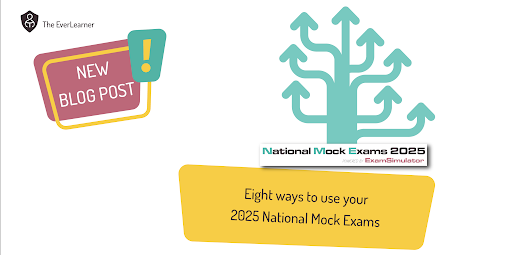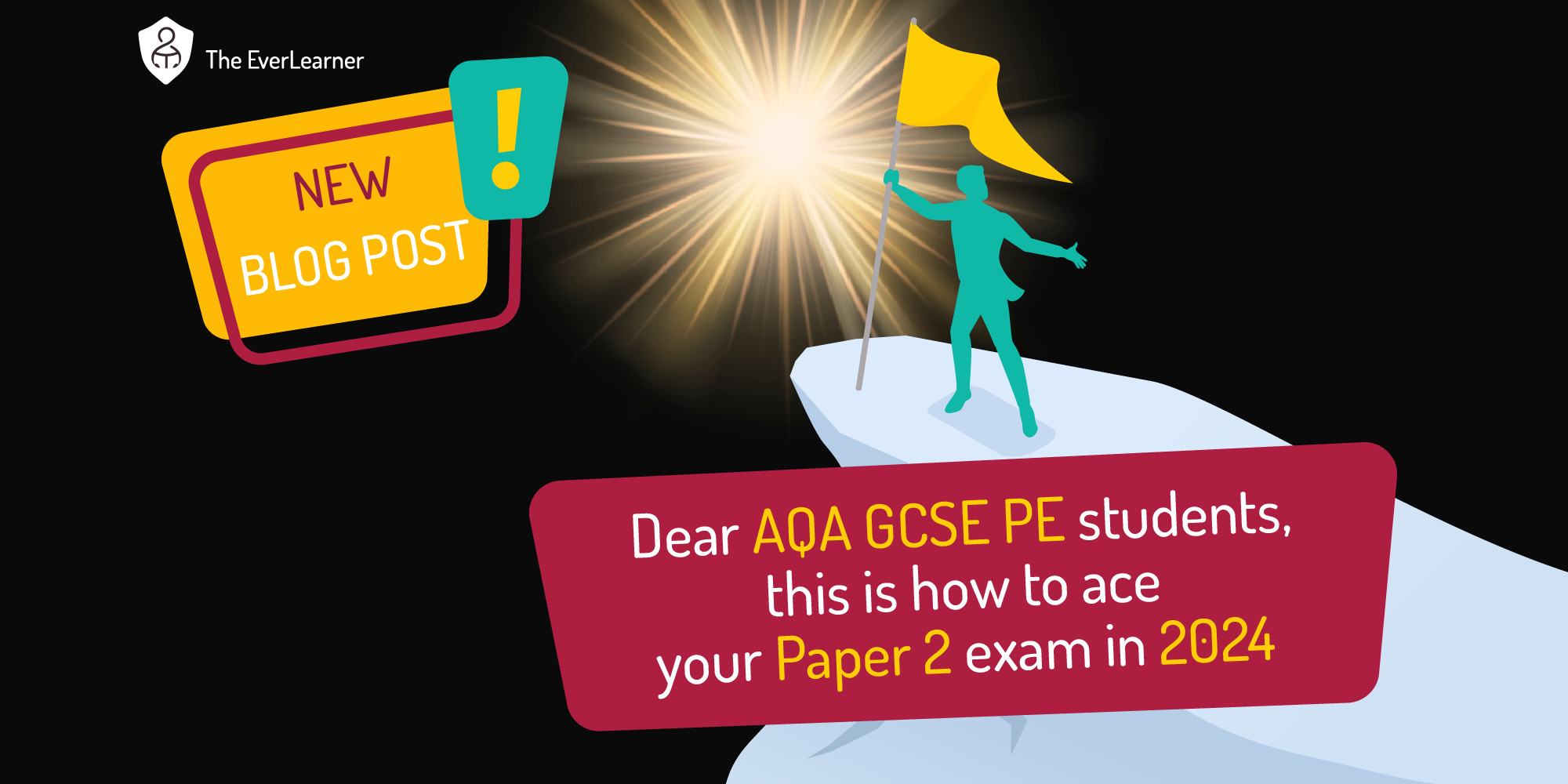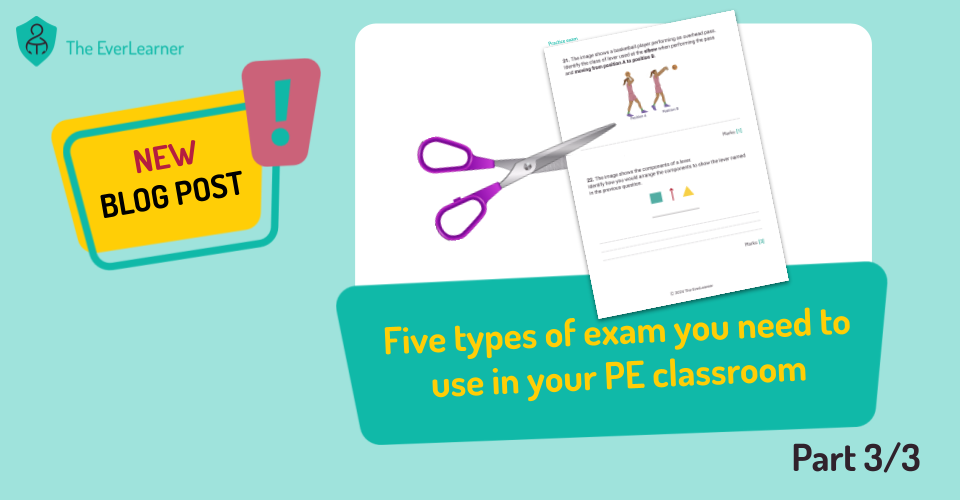Five types of exams you need to use in your PE classroom - Part 1 of 3
In recent posts, I have been writing extensively about exam writing and mark schemes for PE courses. Last week, for example, I highlighted a series of concerns I have about the quality of PE mark schemes. That post got a fair amount of attention so, this week, I want to follow up with some proactive ideas about how PE colleagues might wish to structure exams into their courses.
The five ideas below are not exhaustive nor an attempt to cover all uses of exams in PE classrooms. Rather, they are five common practices that I believe that my students benefit from. Furthermore, I should stress in advance that I strongly endorse the ongoing usage of not only exam questions and marking schemes but, crucially, also model answers, marking practices, collaborative writing, the appropriate use of timers as well as a series of tools that help to build towards an exam experience in class and maintain the learning derived from that practice. You can read more about this in a previous blog: Build, Peak, Maintain.
Here are the five types of exams I am choosing to share with you:
- Collaborative exam writing (released in Part 1)
- Skill-based exam practice (released in Part 2)
- Interleaved exam practice (released in Part 2)
- “Cut-and-paste” exams (released in Part 3)
- Time-restricted exam practice (released in Part 3)
So, let’s get cracking and dive straight in…
Exam type 1: Collaborative exam writing
This one is definitely my favourite purely because it is fun and a bit noisy, it can cause little agreements and disagreements, and it can even foster a little friendly competition. Purely from a memorability perspective, I tend to favour this kind of experience early in a course.
Collaborative exam writing has one core purpose: to create exam writing experiences where knowledge and skills can be witnessed and absorbed from other people. Many other exam writing experiences ask the student “What do you know yourself?” but collaborative writing is different. It asks: “What do you know once you have consulted with the ideas of others?” Let’s look at two different ways to do this:
1.1 Pass the Buck
I love Pass the Buck. I mean, I love it!! If you took Pass the Buck away, if it didn’t exist anymore, I’m not sure I’d want to be a teacher anymore and certainly not a teacher of an examined course. This is how it works:

In essence, pass the buck involves students working in pairs, trios or quads (I wouldn’t go bigger than four) on an exam question or series of questions. They have a sheet of paper with the questions on and they have a specifically coloured pen. They receive a time limit (such as three minutes or four minutes – don’t go over four and a half minutes, though; it doesn’t work as well) and they do their best to write answers or partial answers in that time frame with their specifically coloured pen. Upon the time being up, they pass their paper to the next group and continue on from the partial answers that they have been passed. This forces them to read the previous attempts and understand them, absorb them and be prepared to improve on them. This process continues until the teacher deems the cycle is up. Peer marking then occurs and points are awarded for correct answers made in specific colours. The teacher can make this a little competition if they like: give prizes, celebrate… whatever feels right in your classroom.
Pass the buck is an absolute banger when it is done well! A banger! Forget the fun and the noise and the competition. Simply put: students spend about 20 minutes writing exam answers, reading answers from others, trying to improve on existing answers, trying to work under timed conditions, etc. It really helps. Now, there are weaknesses too. This is not an assessment. Clearly, this is practice but it is practice with an impact.
Here’s video guidance on Pass the buck if it helps:
1.2: Idea piles
If you thought I was enthusiastic about Pass the Buck as a collaborative writing experience, get ready for Idea piles. Idea piles has one core aim: to develop the ‘Analyse’ skill (or exam command). To analyse, typically, means to break a concept into parts and explain it and it is a crucial skill on many PE courses. Idea piles allows teachers to develop the skill. Here’s how:

Let's say your exam question is something along the lines of “Analyse the impact of lifelong physical activity on health” and that the question is on the whiteboard visible to all. Students would need to break their answers into –presumably– physical health, emotional/mental health and social health and explain each. Idea piles CAUSES them to act in this way.
A group of three or four students (try not to go above consoles of four, as it can create isolates too frequently) sit together and have three “piles” on their table. These “piles” can be containers or just coloured paper or whatever you have. I have used those smallish tin coffee pots that are popular these days - the ones that are the size of a can of Coke and have a rubber lid. They work brilliantly! Anyhow, there also needs to be three sets of little coloured card or paper slips. Once the timer starts on the task, students, in silence, take the relevant coloured slip, write their idea about physical health, say, and place it in the physical health pot. Then they do this again for social health and so on. Typically, each student will write a slip of paper about once every twenty seconds, which means that, after five minutes, the pots are pretty full. This has all been done in silence. Then give the group another three minutes, say, to extract the slips and discuss which contain the best or most thorough or most repeated ideas. You could ask them to pick three or four of each. Then, once they have selected the ideas they prefer, the group can have a time limit of five or seven minutes to write their ‘Analyse’ response. Upon completion, peer marking can occur and the nature of analysing can be discussed.
I also recommend that you use the ‘Analyse’ Roadmap when first attempting to write analyse responses. This can be found here: The EverLearner Roadmap. This could be the basis of a whole other post but you can extract the core idea here:


Hopefully, you can see that these practices build exam skills specifically and do so in a manner that is collaborative and developmental.
1.3 Agreement circles
Oh my! I don’t think I have done a single lesson that requires evaluative thinking without agreement circles for at least ten years. It is soooooo good! Agreement circles, speaking purely, isn’t an exam-writing experience but it should be seriously considered in the moments before students write ‘Evaluate’ command exam answers.
Let’s say that you are building up to a question such as “Evaluate the impact of hosting the summer and winter Olympic and Paralympic games on host countries.” Clearly, students would need to provide both positives and negatives for hosts and be able to reach an informed judgement. This is where Agreement circles comes in because it provides the nutrition for the answer. Here’s how it works:

Get your group standing or sitting in a circle. Go out of the classroom if you need to. 😲
Pose a statement to them such as “Hosting a major sporting event has an overall positive impact for a host city.” Notice the word city, not country, which is the question we are going to answer later. Have students step in if they agree and out if they disagree. Have them note down their main reasons for their decision (they may not stay neutral) on their mini whiteboard. Encourage discussion whether contradictory or in agreement and get those brilliant ideas of the students recorded onto a centralised flipchart or whiteboard.
Now, go again and this time change something. State: “Hosting a major sporting event has an overall positive impact for a host country” or “Hosting a major sporting event has an entirely positive impact for a host city/country.” This will cause people to think differently and more than before. Again, get all good ideas recorded onto a central record such as your whiteboard.
At this point, you are almost but not quite ready to go and do some writing. Before the students return to their desks to write an answer to the question, cause the group to find a consensus and help them to form this consensus into a conclusion. Record the nature of this conclusion too.
At this point, students return to their desks and, probably in silence, complete a timed essay based on the question:
“Evaluate the impact of hosting the summer and winter Olympic and Paralympic games on host countries.”
You can have the central record uncovered or covered. You can uncover it for some of the time such as the first three minutes and then cover it. This might cause the students to write a plan. You may be able to think of other ways to use the model too. But, crucially, Agreement circles CAUSES the behaviour of evaluation and I urge you to consider using it.
So, there you have it: part one of this five-part epic. Please return to the post for the next instalment, where I’ll write about skill-based exams and interleaved exams.
Have a lovely day.
James
%20Text%20(Violet).png)


